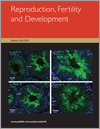Congratulations Zhibing Zhang, MD, PhD - Figure 4 of Elongin B Paper Featured on the Cover of Issue 5 of Reproduction, Fertility and Development

Zhibing Zhang, MD, PhD
Associate Professor
Departments of Physiology, and Obstetrics and Gynecology

The formation of mature male germ cells utilizes many germ cell-specific transcripts. Some are derived from the same genes as somatic cells but differ in size and/or overall sequence through the use of alternate promoters and transcription factor complexes, alternative splicing events, and use of alternative polyadenylation sites. Disruption of any of these mechanisms of formation of germ cell-specific transcripts may result in failure of spermatogenesis. We previously reported that depletion of sperm associated antigen 16S (SPAG16S), a male germ cell specific nuclear protein caused spermatogenic failure. In this study, we identified Elongin B, a regulatory subunit of the trimeric elongation factor ElonginABC, which increases the overall rate of elongation by RNA polymerase II, as a major binding partner of SPAG16S. Elongin B is highly abundant in the testis, and both SPAG16S and Elongin B are present in nuclear speckles (NSs), subcompartments in the nuclei that are enriched in pre-mRNA splicing factors and involved in RNA maturation. Proteins in NSs are also crucial for epigenetic regulation, chromatin organization, DNA repair and RNA modification. We hypothesize that Elongin B forms a complex with SPAG16S in the nuclei/NSs to function as a male germ cell-specific mRNA splicing complex. The long-term of this research will uncover novel pathways that generate male germ-specific transcripts.